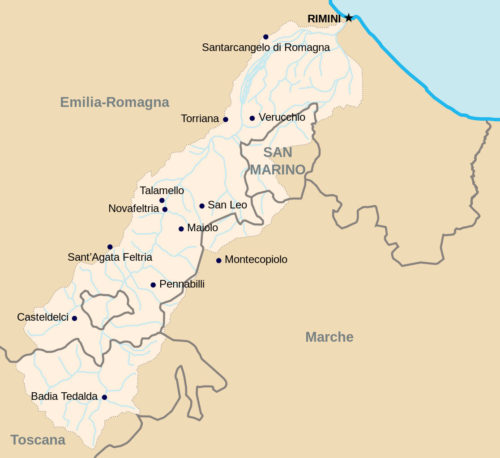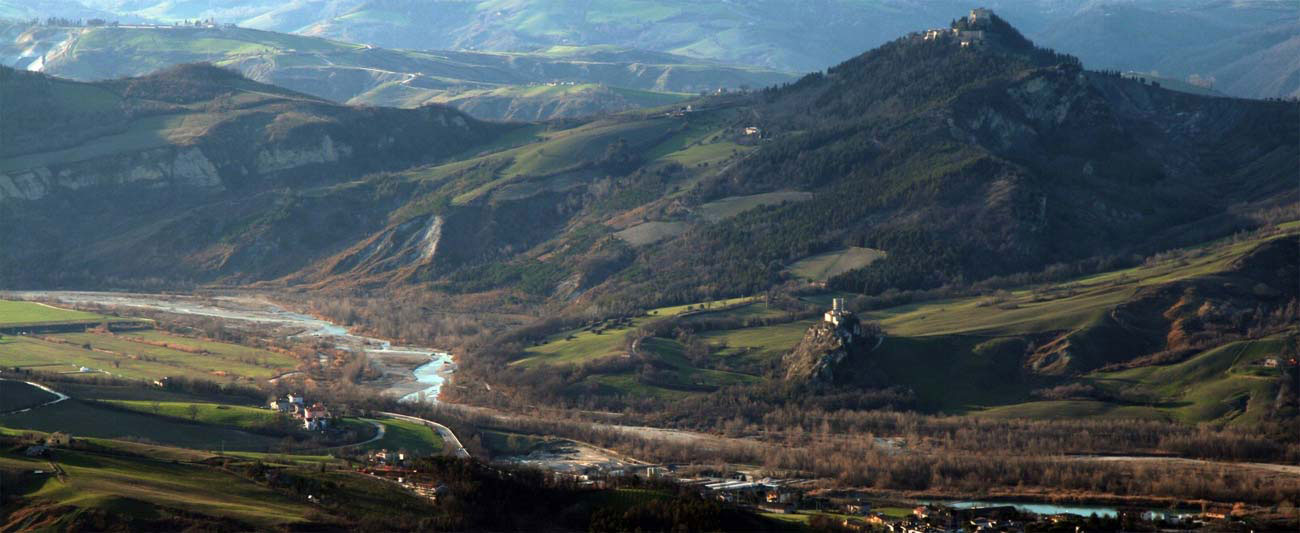Changes in the medieval Italian landscape were often dramatic. And, yet, micro-studies of districts, like the Valmarecchia in Emilia Romagna, reveal both continuity and change.
 Map of Valmarecchia in Emilia Romagna, Italy Source: Wikipedia
Map of Valmarecchia in Emilia Romagna, Italy Source: WikipediaFor twenty years Daniele Sacco has been studying the Valley of the Marecchia – the Valmarecchia. The river, which flows through two regions – the Emilia-Romagna and the Marche, was inhabited before Roman times. An ancient trade route, it later became the battleground for some of the most eye-catching medieval feuds between the families of the Malatesta and the Montefeltro.
Through careful field-walking, land surveys, and stratigraphic studies his team has succeeded in getting a very detailed view of the history of the landscape as it changed from the earliest times to the 16th century. Involved have been archaeologists, geologists, archeo-botanists, historians, art historians, etc. As a consequence of this work, Daniele Sacco, who has been in charge of the project, has been able to nuance and qualify the question of how the incastellation (incastellamento) played out in detail.
The Valmarecchia covers 683 m2 and covers the southern part of Emilia Romagna as well as the northern part of Marche. Heartland of the Dukes of Urbino it may be identified as a sub-region of the Montefeltro. However, today it is better known as the hilly hinterland of the provinces of Rimini and Pesaro-Urbino. It is also the landscape in which we find the Republic of San Marino. The name derives from the river Marecchia, which runs for more than 70 km out to the sea at Rimini. At the upper end, the landscape is characterised by steep slopes, and the valley is narrow and the surroundings mountainous. Quickly, though, it widens up and becomes more hilly and gentle. Since ancient times, people have lived on some of the hilly plateaus, primarily around present day San Leo, Verucchio and at Monte Titano, which harbours the Republic of San Marino.
Population through Time
 Gattara di Casteldelci. Source: Panoramio
Gattara di Casteldelci. Source: PanoramioOne of the first initiatives of the team was to discover the population density at different times. The history begins in 268 BC when the coastal colony of Arminum (Ariminum or Rimini) was settled. Later, the region belonged to the VI Roman region: Umbria to be changed by Hadrian into the Flaminia et Picenum. Rimini was the main city and also a major road junction, linking the Via Flaminia, Via Emilia and Via Popolia (Annia). Via Ariminensis, as it has been called by modern convention, was a minor road, which traversed the Apennines to Arezzo, from where travellers could proceed to Rome. This road, no more than a hilly path, was ancient and known before the Roman Age. In Roman times, the Valmarecchia was divided into three municipia, with Rimini as its central hub. Field surveys have shown that this road – the Via Ariminensis – connected some minor settlements, which from the evidence of inscriptions must be characterised as Vici. The area must be characterised as rural, mountainous, and marginal writes Sacco in a recent overview of the results of the project. Although not a fertile land, farms and settlements seem to have been present from the Iron Age and into the first and second centuries CE. Located next to perennial water sources and on south/south-west oriented sloped they cannot be characterised as Roman villas, which were few and far between each other.
However, most of these settlements and farms declined in the fourth century to be abandoned in the fifth. It appears that the landscape simply started to collapse. Scattered farms, small hamlets, and the tiny villas simply disappeared. Area photos substantiate this conclusion. There is also no evidence that these sites were later resettled. Perhaps some Goths settled along the coast, but the evidence is sparse. In the seventh century, there is no evidence of human settlement in the valleys anymore, only some signs that the migrants occasionally used them as a transit area from Arezzo to the coast. This was a period of chronic wars, deteriorating climate and plague.
What happened was that the few remaining descendants of the Roman population hastily moved up to higher lands. Abandoning roads, ruins, and the flooded valleys, they resettled in locations like the Macerata Feltria and Pennabili. Later in the 8th and 9th century, these settlements became gradually controlled by an elite, which in the 10th century turned into a class of nobles busy constructing castles above these mountainous settlements.
However, the team involved in researching this micro-history of a landscape has concluded that although it seems as if these new hill-top settlements were new, they nevertheless reflected the ancient Roman pattern of settlement. They just moved up onto the hilltops, often no more than a few hundred metres from the old Roman settlements. This was, for instance, the case with the villages at Casteldelci and Sant’Agatha Feltria in the northern part of the Valmarecchia.
One of the interesting features of this development was the way in which these new hilltop settlements had churches dedicated to Lombard saints, while the churches further below in the valleys were dedicated to Roman saints. Some of these catered for pilgrims and functioned as hopitals.
 Valmarecchia. One of the reasons why early medieval people moved to the hilltops were probably to get away from the flooding caused by the deteriorating climate. Source: Google Map
Valmarecchia. One of the reasons why early medieval people moved to the hilltops were probably to get away from the flooding caused by the deteriorating climate. Source: Google MapConclusion
What seemed to happen was that at first – in the 5th and 6th centuries – people were harassed by the times and moved to settle further up and closer to each other. Gradually in the next centuries, this resulted in hill-top villages dotting the landscape. Later in the 7th and 8th century, the Lombard elite invaded from the east, strengthening the fortifications and building (Lombard) churches at these hill-top settlements, which they already found dotting the landscape. Even later, in the 9th to 11th century, these settlements were fitted with castles built by local elites – often petty nobles – thus constructing the landscape as we meet it today with its many fortified hill-top villages.
However, when the Carolingians conquered Lombardy and Northern Italy in the 8th century, a distinct diocese was set up in the area – the Diocese of Montefeltro. The first of these bishops, Agatho, resided in San Leo, where the remains of his church may still be seen. These bishops, who also acted as counts, had numerous parish churches built near the former Roman settlements, which were still lying down below the slopes. It appears at least part of the populace still frequented these downhill churches. It also seems, that even if land surveys have shown that there is virtually no evidence of sporadic farms or settlements in the open country or on the floors of the valleys at this time, churches were constructed outside the fortified settlements.
In short: when the population and the landscape of Valmarecchio declined in the 5th and 6th centuries, people took to the hills to help each other out with the defence against the different invaders, whether Goths, Lombards, or just unidentified pirates and robbers. These uphill settlements were generally not far from the old Roman settlements. Later, these villages were fitted with castles and further fortifications, walls. However, some hill-top settlements complete with castles were also built ex novo in the 10th and 11th century, demonstrating that the trend to live in fortified villages on top of hills were a ubiquitous feature of the high medieval landscape. Such a castle was the one located on the Monte Copiolo, surging 1030 metres above the sea. Remains of settlements have not been found here between the 4th and the 9th centuries, and it appears the mountain was not inhabited until the first castle was built in the 10th century by the counts of Carpegna. Later taken over by the Counts of Montefeltro, it became their initial and best-defended stronghold. The castle at Monte Copiolo was never conquered and remained in the hands of the Dukes of Urbino. Later in the 17th century, people abandoned the castle and moved downwards to live on the more fertile slopes. Extensive excavations carried out since 1997 by the team led by Daniele Sacco, have revealed the history of this castle in detail.
It appears the Italian landscape in Valmarecchia went through numerous periods alternating expansions and contractions. Only some of this was caused by the notorious Italian process of incastellation (incastellamento)
SOURCES:
Exploring Valmarecchia. Diachrony of Population Development from th...
By Daniele Sacco
Lac 2014 Proceedings
La Fortezza di Montefeltro. San Leo: processi di trasformazione, archeologia dell’architettura e restauri storici
By Daniele Sacco and Alessandro Tosarelli
ArcheoMed. Universià degli studi di Urbino Carlo Bo. Collana dell’ Insegnamento di Archeologia Medievale. Monographia III.
All’Insegna del Giglio, 2016
ABOUT THE AUTHOR:
Daniele Sacco is professor at the University of Urbino, “Carlo Bo”. In the last twenty years his research interest has been focussed on the archaeology of transformation processes affecting landscapes, settlements and buildings in central-northern Italy, from the Late Antiquity to the late Middle Ages, by using the tools offered by geomorphology. Special attention is devoted to the diachronic evolution of settlements and to the relation between society and the surrounding environment (environmental archaeology, landscape archaeology). His favourite study topics are the collapse of ancient landscapes, encastellation, stone production systems and hospital healthcare forms in the Early and Late Middle Ages, appearing mainly as a direct consequence of pilgrimage. For years, he has been carrying out stratigraphic and archaeological excavations, as well as surveys on the archaeology of buildings.
FEATURED PHOTO:
Petrella in Valmarecchia. Source: Pinterest/ Guida Gianlucca
 http://www.medievalhistories.com/wp-content/uploads/Petrella-source-pinterest-guida-gianlucca-moretti-500x333.jpg 500w,
http://www.medievalhistories.com/wp-content/uploads/Petrella-source-pinterest-guida-gianlucca-moretti-500x333.jpg 500w, 












Pentru a putea adăuga comentarii trebuie să fii membru al altmarius !
Alătură-te reţelei altmarius